HRMG308: Self Analysis, Conflict Management, and Communication
VerifiedAdded on 2022/12/27
|7
|1752
|62
Report
AI Summary
This report presents a self-analysis conducted by a student, focusing on self-identity, personality traits, and their impact on conflict management and communication within an organizational context. The student utilizes assessment tools such as the Johari Window, Myers-Briggs Type Indicator (MBTI), and DISC test to gain insights into their strengths, weaknesses, and behavioral patterns. The analysis includes reflections on cultural background, comparisons with others, and identification of blind spots and surprising aspects of their personality. The report further explores the student's experiences with conflict management, detailing specific instances and the underlying causes of conflicts. Finally, the student outlines strategies for improving conflict management skills, emphasizing the importance of building rapport, addressing anxieties, and adopting proactive approaches to resolve conflicts. The report concludes with an emphasis on the ongoing nature of self-improvement and the importance of effective conflict management for a successful career.
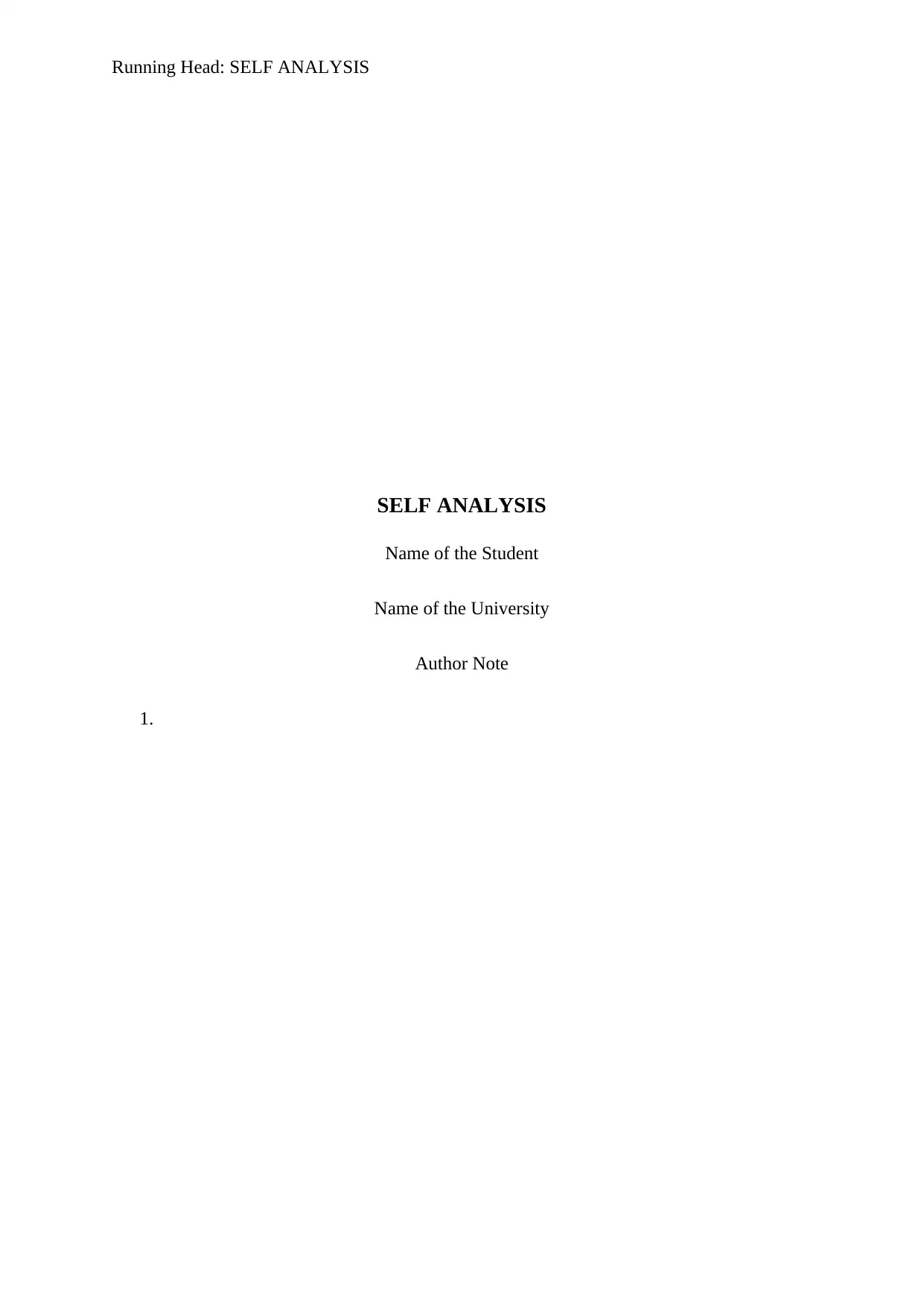
Running Head: SELF ANALYSIS
SELF ANALYSIS
Name of the Student
Name of the University
Author Note
1.
SELF ANALYSIS
Name of the Student
Name of the University
Author Note
1.
Paraphrase This Document
Need a fresh take? Get an instant paraphrase of this document with our AI Paraphraser
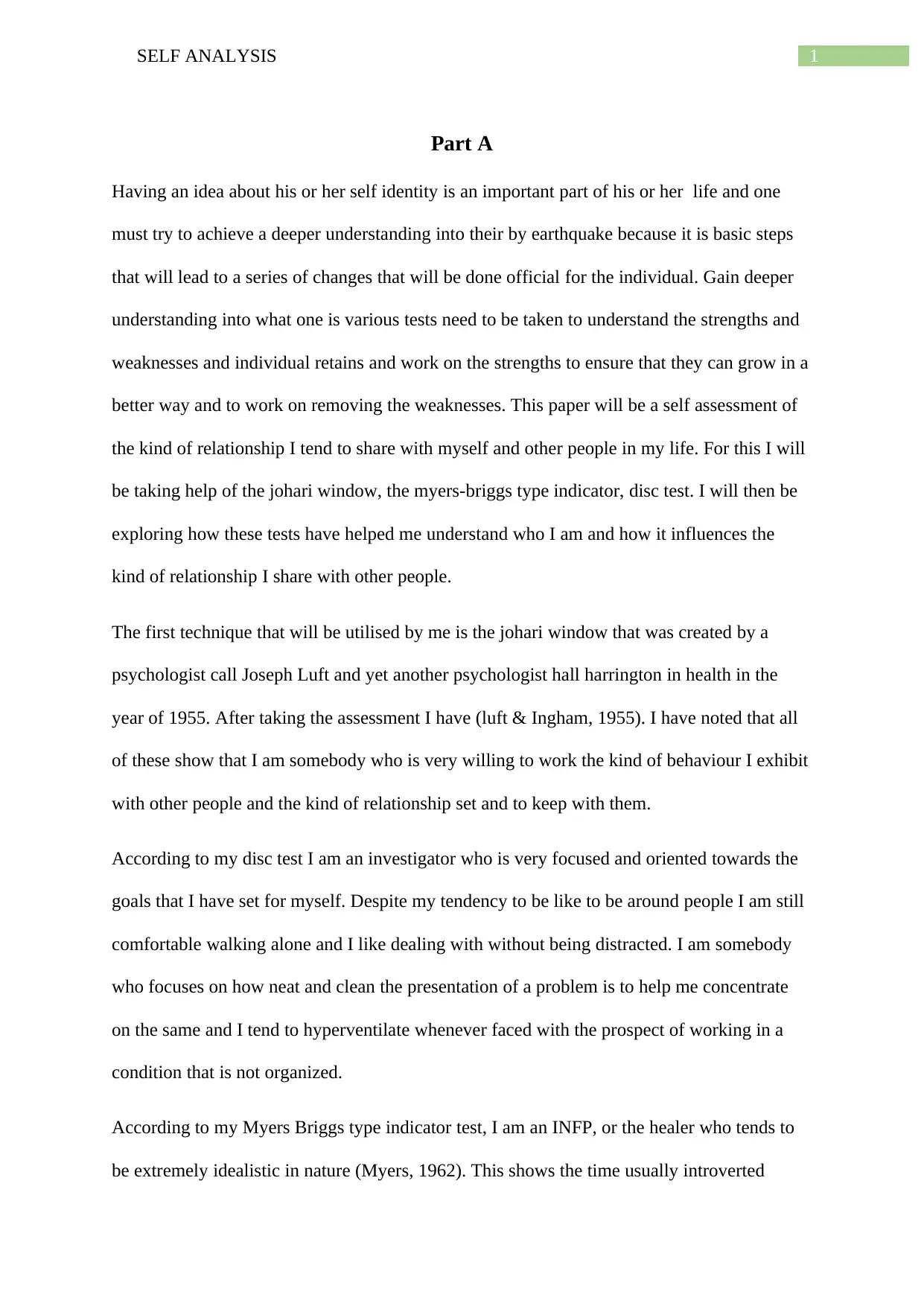
1SELF ANALYSIS
Part A
Having an idea about his or her self identity is an important part of his or her life and one
must try to achieve a deeper understanding into their by earthquake because it is basic steps
that will lead to a series of changes that will be done official for the individual. Gain deeper
understanding into what one is various tests need to be taken to understand the strengths and
weaknesses and individual retains and work on the strengths to ensure that they can grow in a
better way and to work on removing the weaknesses. This paper will be a self assessment of
the kind of relationship I tend to share with myself and other people in my life. For this I will
be taking help of the johari window, the myers-briggs type indicator, disc test. I will then be
exploring how these tests have helped me understand who I am and how it influences the
kind of relationship I share with other people.
The first technique that will be utilised by me is the johari window that was created by a
psychologist call Joseph Luft and yet another psychologist hall harrington in health in the
year of 1955. After taking the assessment I have (luft & Ingham, 1955). I have noted that all
of these show that I am somebody who is very willing to work the kind of behaviour I exhibit
with other people and the kind of relationship set and to keep with them.
According to my disc test I am an investigator who is very focused and oriented towards the
goals that I have set for myself. Despite my tendency to be like to be around people I am still
comfortable walking alone and I like dealing with without being distracted. I am somebody
who focuses on how neat and clean the presentation of a problem is to help me concentrate
on the same and I tend to hyperventilate whenever faced with the prospect of working in a
condition that is not organized.
According to my Myers Briggs type indicator test, I am an INFP, or the healer who tends to
be extremely idealistic in nature (Myers, 1962). This shows the time usually introverted
Part A
Having an idea about his or her self identity is an important part of his or her life and one
must try to achieve a deeper understanding into their by earthquake because it is basic steps
that will lead to a series of changes that will be done official for the individual. Gain deeper
understanding into what one is various tests need to be taken to understand the strengths and
weaknesses and individual retains and work on the strengths to ensure that they can grow in a
better way and to work on removing the weaknesses. This paper will be a self assessment of
the kind of relationship I tend to share with myself and other people in my life. For this I will
be taking help of the johari window, the myers-briggs type indicator, disc test. I will then be
exploring how these tests have helped me understand who I am and how it influences the
kind of relationship I share with other people.
The first technique that will be utilised by me is the johari window that was created by a
psychologist call Joseph Luft and yet another psychologist hall harrington in health in the
year of 1955. After taking the assessment I have (luft & Ingham, 1955). I have noted that all
of these show that I am somebody who is very willing to work the kind of behaviour I exhibit
with other people and the kind of relationship set and to keep with them.
According to my disc test I am an investigator who is very focused and oriented towards the
goals that I have set for myself. Despite my tendency to be like to be around people I am still
comfortable walking alone and I like dealing with without being distracted. I am somebody
who focuses on how neat and clean the presentation of a problem is to help me concentrate
on the same and I tend to hyperventilate whenever faced with the prospect of working in a
condition that is not organized.
According to my Myers Briggs type indicator test, I am an INFP, or the healer who tends to
be extremely idealistic in nature (Myers, 1962). This shows the time usually introverted
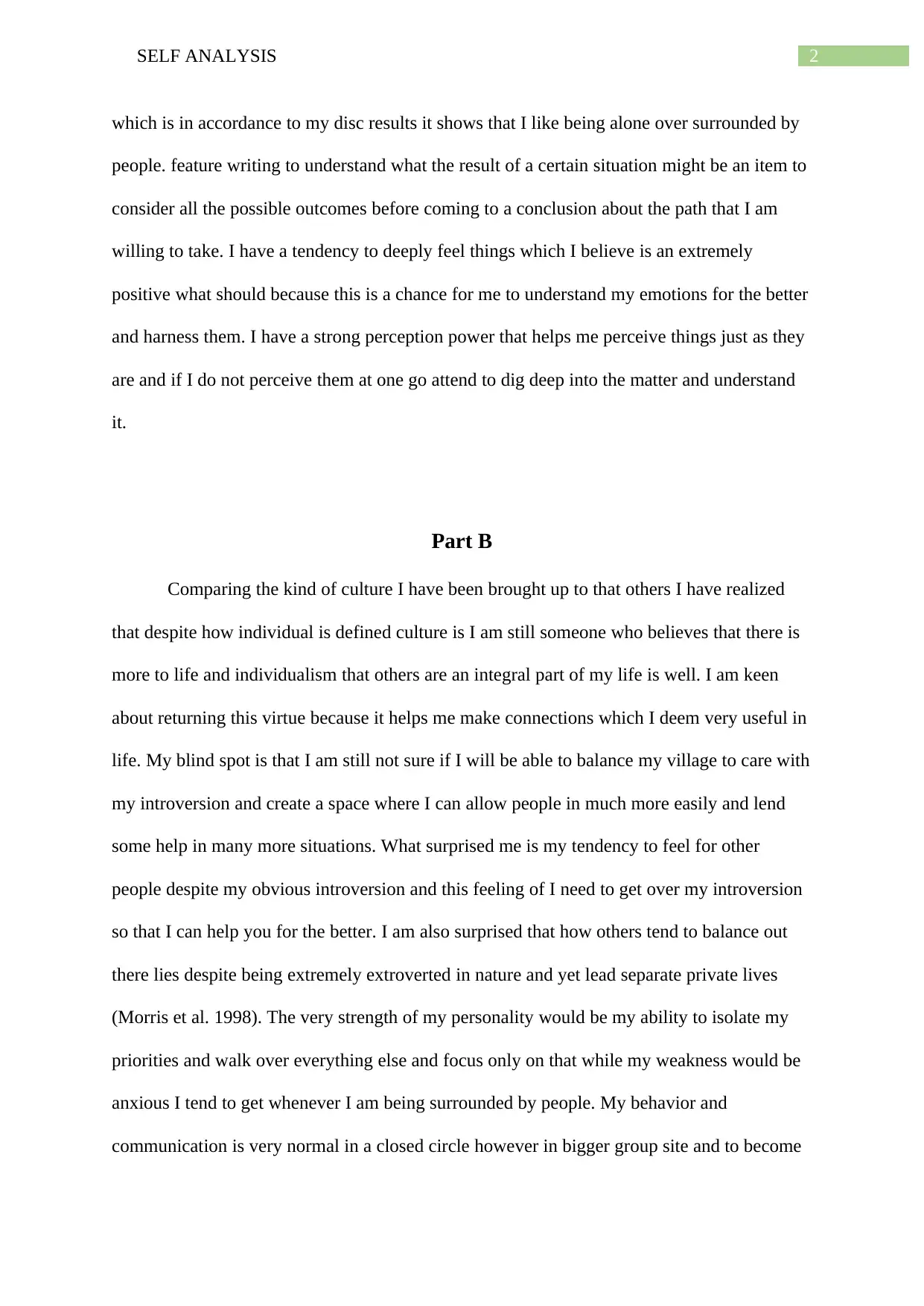
2SELF ANALYSIS
which is in accordance to my disc results it shows that I like being alone over surrounded by
people. feature writing to understand what the result of a certain situation might be an item to
consider all the possible outcomes before coming to a conclusion about the path that I am
willing to take. I have a tendency to deeply feel things which I believe is an extremely
positive what should because this is a chance for me to understand my emotions for the better
and harness them. I have a strong perception power that helps me perceive things just as they
are and if I do not perceive them at one go attend to dig deep into the matter and understand
it.
Part B
Comparing the kind of culture I have been brought up to that others I have realized
that despite how individual is defined culture is I am still someone who believes that there is
more to life and individualism that others are an integral part of my life is well. I am keen
about returning this virtue because it helps me make connections which I deem very useful in
life. My blind spot is that I am still not sure if I will be able to balance my village to care with
my introversion and create a space where I can allow people in much more easily and lend
some help in many more situations. What surprised me is my tendency to feel for other
people despite my obvious introversion and this feeling of I need to get over my introversion
so that I can help you for the better. I am also surprised that how others tend to balance out
there lies despite being extremely extroverted in nature and yet lead separate private lives
(Morris et al. 1998). The very strength of my personality would be my ability to isolate my
priorities and walk over everything else and focus only on that while my weakness would be
anxious I tend to get whenever I am being surrounded by people. My behavior and
communication is very normal in a closed circle however in bigger group site and to become
which is in accordance to my disc results it shows that I like being alone over surrounded by
people. feature writing to understand what the result of a certain situation might be an item to
consider all the possible outcomes before coming to a conclusion about the path that I am
willing to take. I have a tendency to deeply feel things which I believe is an extremely
positive what should because this is a chance for me to understand my emotions for the better
and harness them. I have a strong perception power that helps me perceive things just as they
are and if I do not perceive them at one go attend to dig deep into the matter and understand
it.
Part B
Comparing the kind of culture I have been brought up to that others I have realized
that despite how individual is defined culture is I am still someone who believes that there is
more to life and individualism that others are an integral part of my life is well. I am keen
about returning this virtue because it helps me make connections which I deem very useful in
life. My blind spot is that I am still not sure if I will be able to balance my village to care with
my introversion and create a space where I can allow people in much more easily and lend
some help in many more situations. What surprised me is my tendency to feel for other
people despite my obvious introversion and this feeling of I need to get over my introversion
so that I can help you for the better. I am also surprised that how others tend to balance out
there lies despite being extremely extroverted in nature and yet lead separate private lives
(Morris et al. 1998). The very strength of my personality would be my ability to isolate my
priorities and walk over everything else and focus only on that while my weakness would be
anxious I tend to get whenever I am being surrounded by people. My behavior and
communication is very normal in a closed circle however in bigger group site and to become
⊘ This is a preview!⊘
Do you want full access?
Subscribe today to unlock all pages.

Trusted by 1+ million students worldwide
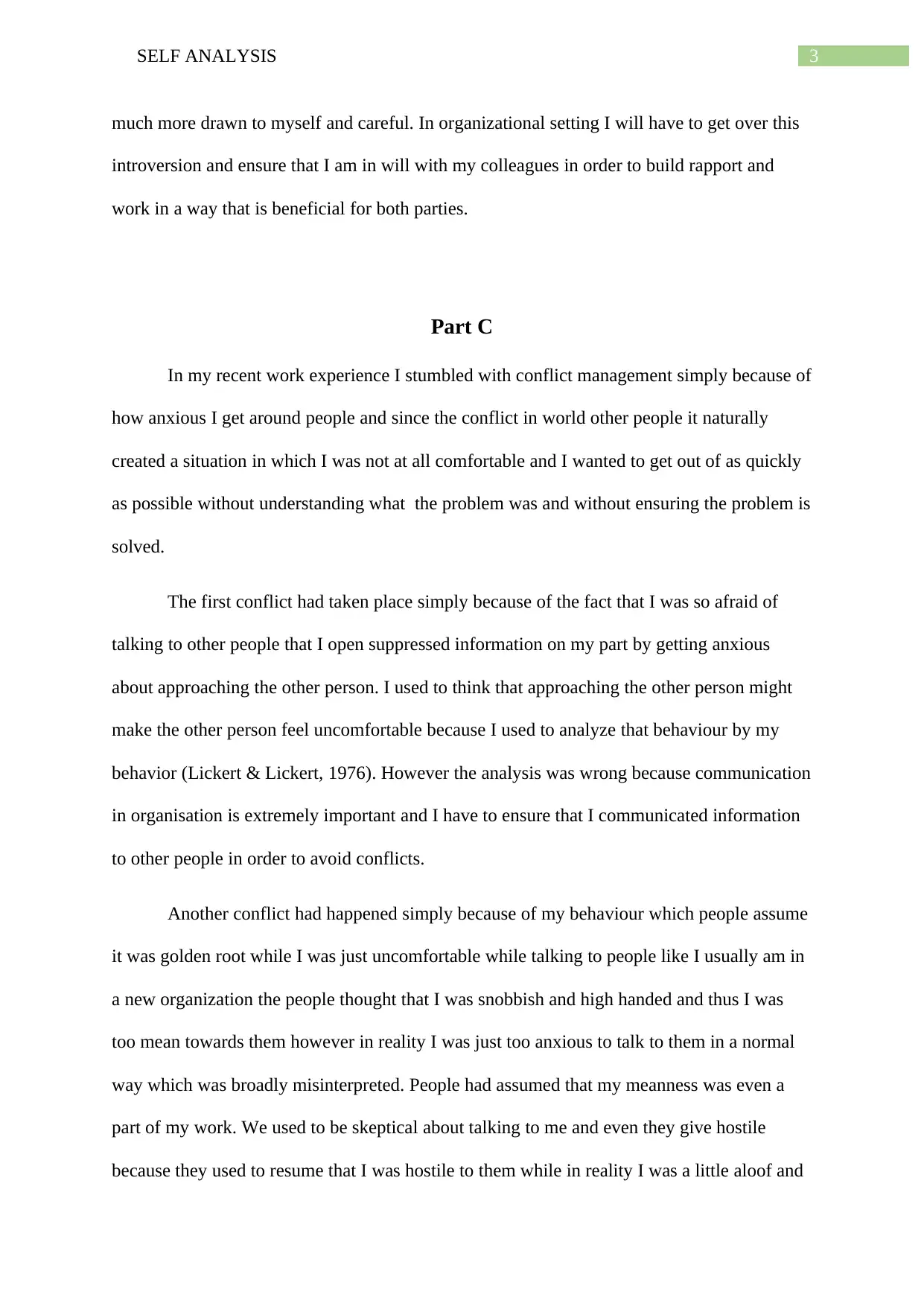
3SELF ANALYSIS
much more drawn to myself and careful. In organizational setting I will have to get over this
introversion and ensure that I am in will with my colleagues in order to build rapport and
work in a way that is beneficial for both parties.
Part C
In my recent work experience I stumbled with conflict management simply because of
how anxious I get around people and since the conflict in world other people it naturally
created a situation in which I was not at all comfortable and I wanted to get out of as quickly
as possible without understanding what the problem was and without ensuring the problem is
solved.
The first conflict had taken place simply because of the fact that I was so afraid of
talking to other people that I open suppressed information on my part by getting anxious
about approaching the other person. I used to think that approaching the other person might
make the other person feel uncomfortable because I used to analyze that behaviour by my
behavior (Lickert & Lickert, 1976). However the analysis was wrong because communication
in organisation is extremely important and I have to ensure that I communicated information
to other people in order to avoid conflicts.
Another conflict had happened simply because of my behaviour which people assume
it was golden root while I was just uncomfortable while talking to people like I usually am in
a new organization the people thought that I was snobbish and high handed and thus I was
too mean towards them however in reality I was just too anxious to talk to them in a normal
way which was broadly misinterpreted. People had assumed that my meanness was even a
part of my work. We used to be skeptical about talking to me and even they give hostile
because they used to resume that I was hostile to them while in reality I was a little aloof and
much more drawn to myself and careful. In organizational setting I will have to get over this
introversion and ensure that I am in will with my colleagues in order to build rapport and
work in a way that is beneficial for both parties.
Part C
In my recent work experience I stumbled with conflict management simply because of
how anxious I get around people and since the conflict in world other people it naturally
created a situation in which I was not at all comfortable and I wanted to get out of as quickly
as possible without understanding what the problem was and without ensuring the problem is
solved.
The first conflict had taken place simply because of the fact that I was so afraid of
talking to other people that I open suppressed information on my part by getting anxious
about approaching the other person. I used to think that approaching the other person might
make the other person feel uncomfortable because I used to analyze that behaviour by my
behavior (Lickert & Lickert, 1976). However the analysis was wrong because communication
in organisation is extremely important and I have to ensure that I communicated information
to other people in order to avoid conflicts.
Another conflict had happened simply because of my behaviour which people assume
it was golden root while I was just uncomfortable while talking to people like I usually am in
a new organization the people thought that I was snobbish and high handed and thus I was
too mean towards them however in reality I was just too anxious to talk to them in a normal
way which was broadly misinterpreted. People had assumed that my meanness was even a
part of my work. We used to be skeptical about talking to me and even they give hostile
because they used to resume that I was hostile to them while in reality I was a little aloof and
Paraphrase This Document
Need a fresh take? Get an instant paraphrase of this document with our AI Paraphraser
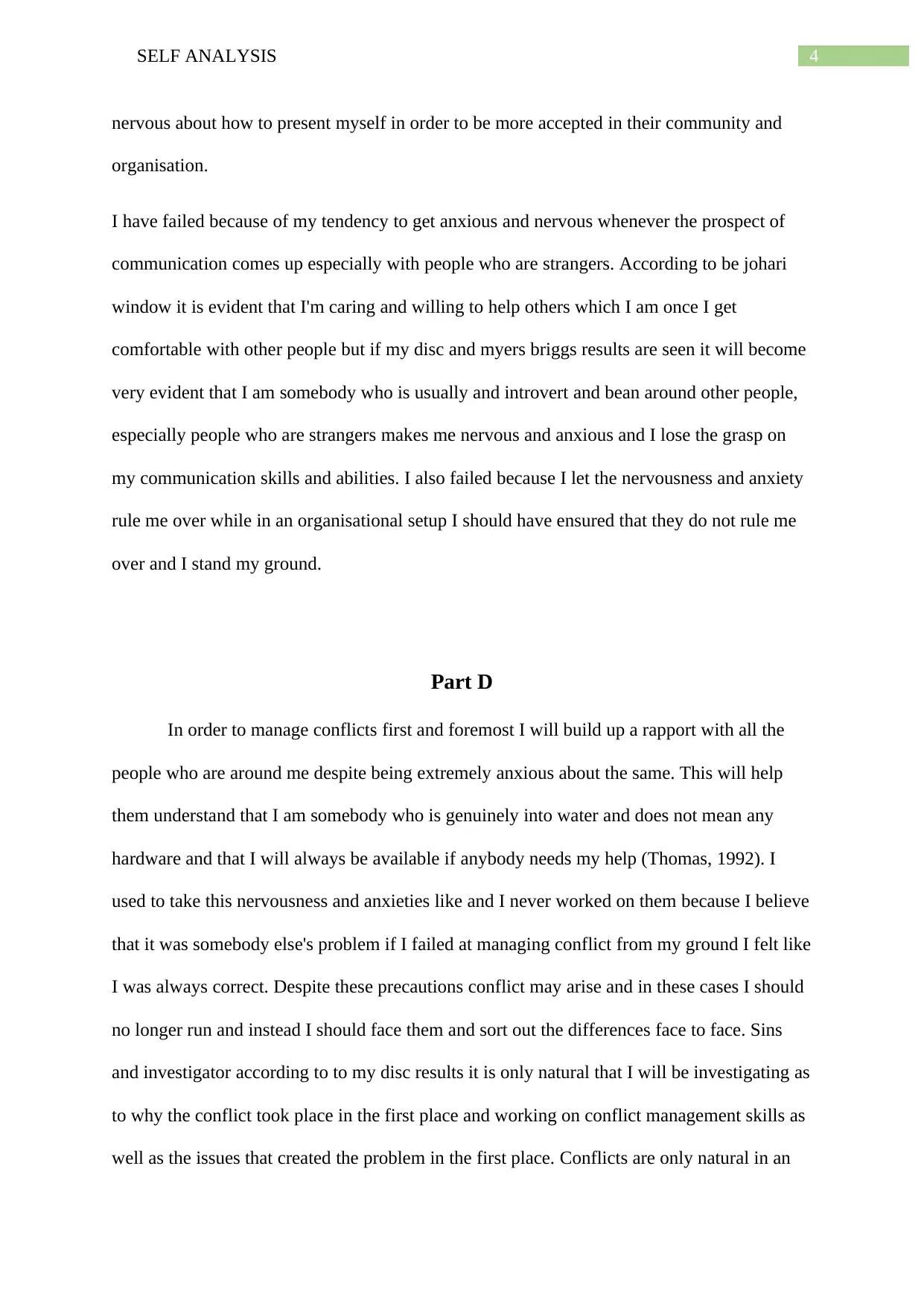
4SELF ANALYSIS
nervous about how to present myself in order to be more accepted in their community and
organisation.
I have failed because of my tendency to get anxious and nervous whenever the prospect of
communication comes up especially with people who are strangers. According to be johari
window it is evident that I'm caring and willing to help others which I am once I get
comfortable with other people but if my disc and myers briggs results are seen it will become
very evident that I am somebody who is usually and introvert and bean around other people,
especially people who are strangers makes me nervous and anxious and I lose the grasp on
my communication skills and abilities. I also failed because I let the nervousness and anxiety
rule me over while in an organisational setup I should have ensured that they do not rule me
over and I stand my ground.
Part D
In order to manage conflicts first and foremost I will build up a rapport with all the
people who are around me despite being extremely anxious about the same. This will help
them understand that I am somebody who is genuinely into water and does not mean any
hardware and that I will always be available if anybody needs my help (Thomas, 1992). I
used to take this nervousness and anxieties like and I never worked on them because I believe
that it was somebody else's problem if I failed at managing conflict from my ground I felt like
I was always correct. Despite these precautions conflict may arise and in these cases I should
no longer run and instead I should face them and sort out the differences face to face. Sins
and investigator according to to my disc results it is only natural that I will be investigating as
to why the conflict took place in the first place and working on conflict management skills as
well as the issues that created the problem in the first place. Conflicts are only natural in an
nervous about how to present myself in order to be more accepted in their community and
organisation.
I have failed because of my tendency to get anxious and nervous whenever the prospect of
communication comes up especially with people who are strangers. According to be johari
window it is evident that I'm caring and willing to help others which I am once I get
comfortable with other people but if my disc and myers briggs results are seen it will become
very evident that I am somebody who is usually and introvert and bean around other people,
especially people who are strangers makes me nervous and anxious and I lose the grasp on
my communication skills and abilities. I also failed because I let the nervousness and anxiety
rule me over while in an organisational setup I should have ensured that they do not rule me
over and I stand my ground.
Part D
In order to manage conflicts first and foremost I will build up a rapport with all the
people who are around me despite being extremely anxious about the same. This will help
them understand that I am somebody who is genuinely into water and does not mean any
hardware and that I will always be available if anybody needs my help (Thomas, 1992). I
used to take this nervousness and anxieties like and I never worked on them because I believe
that it was somebody else's problem if I failed at managing conflict from my ground I felt like
I was always correct. Despite these precautions conflict may arise and in these cases I should
no longer run and instead I should face them and sort out the differences face to face. Sins
and investigator according to to my disc results it is only natural that I will be investigating as
to why the conflict took place in the first place and working on conflict management skills as
well as the issues that created the problem in the first place. Conflicts are only natural in an
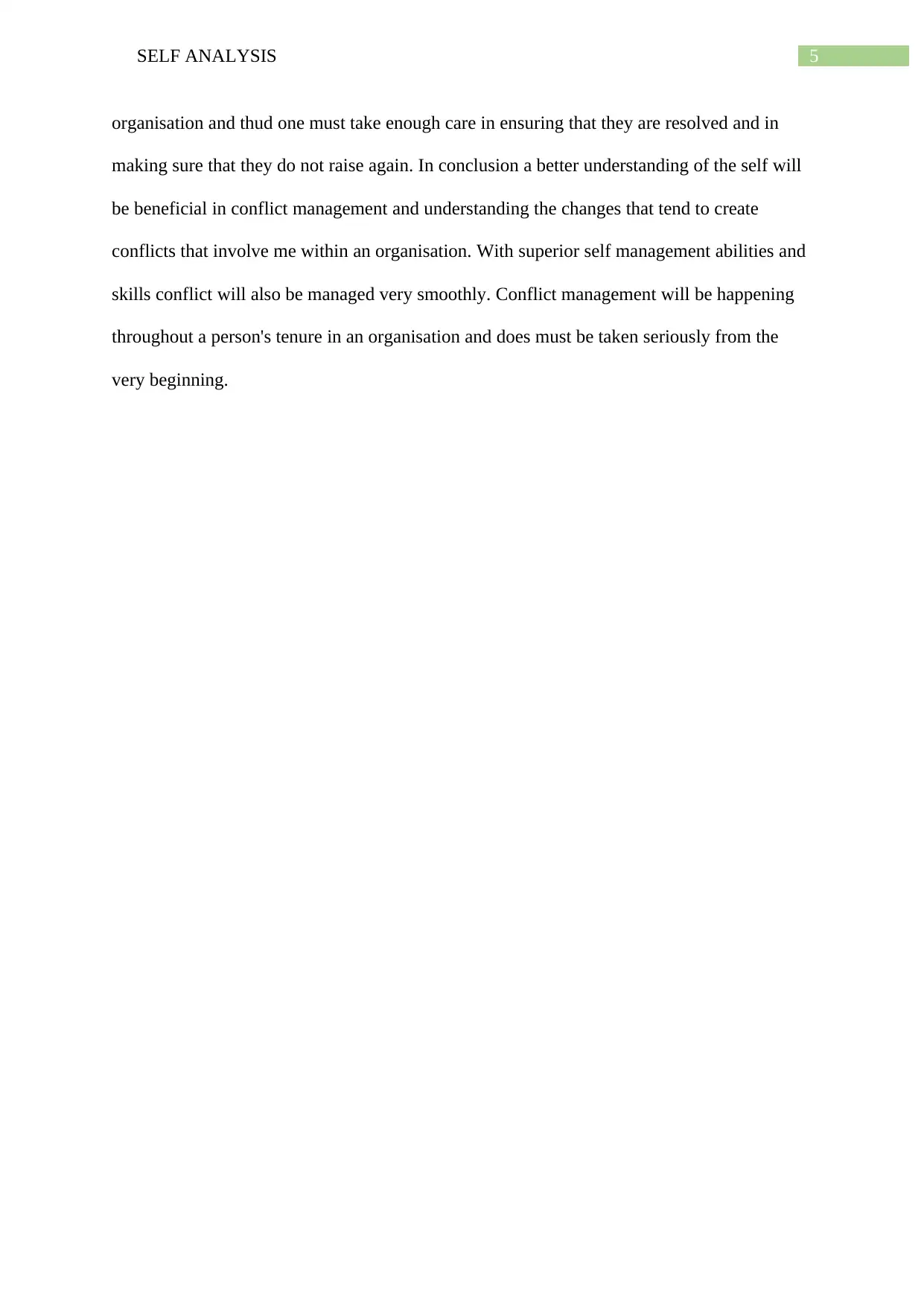
5SELF ANALYSIS
organisation and thud one must take enough care in ensuring that they are resolved and in
making sure that they do not raise again. In conclusion a better understanding of the self will
be beneficial in conflict management and understanding the changes that tend to create
conflicts that involve me within an organisation. With superior self management abilities and
skills conflict will also be managed very smoothly. Conflict management will be happening
throughout a person's tenure in an organisation and does must be taken seriously from the
very beginning.
organisation and thud one must take enough care in ensuring that they are resolved and in
making sure that they do not raise again. In conclusion a better understanding of the self will
be beneficial in conflict management and understanding the changes that tend to create
conflicts that involve me within an organisation. With superior self management abilities and
skills conflict will also be managed very smoothly. Conflict management will be happening
throughout a person's tenure in an organisation and does must be taken seriously from the
very beginning.
⊘ This is a preview!⊘
Do you want full access?
Subscribe today to unlock all pages.

Trusted by 1+ million students worldwide
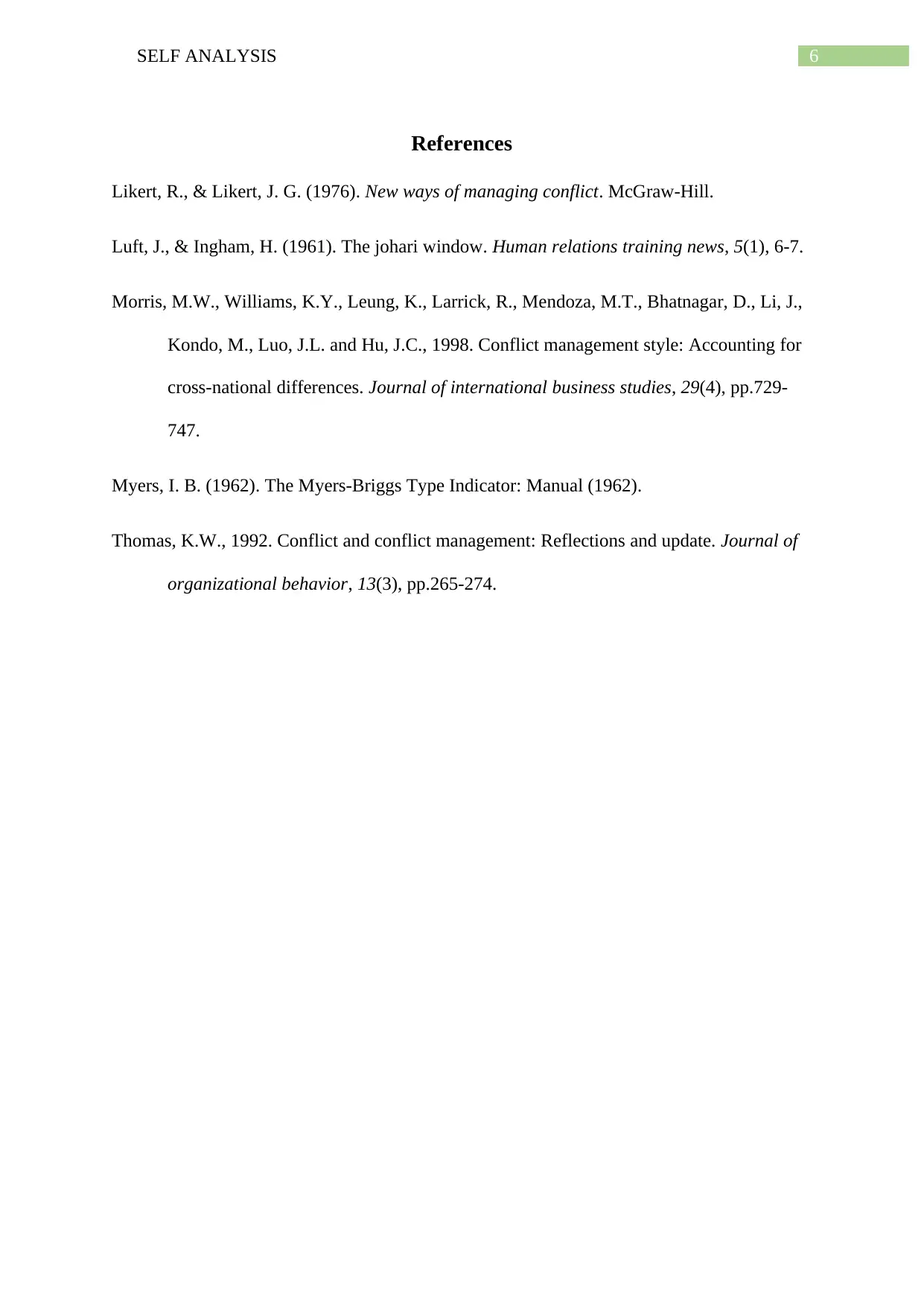
6SELF ANALYSIS
References
Likert, R., & Likert, J. G. (1976). New ways of managing conflict. McGraw-Hill.
Luft, J., & Ingham, H. (1961). The johari window. Human relations training news, 5(1), 6-7.
Morris, M.W., Williams, K.Y., Leung, K., Larrick, R., Mendoza, M.T., Bhatnagar, D., Li, J.,
Kondo, M., Luo, J.L. and Hu, J.C., 1998. Conflict management style: Accounting for
cross-national differences. Journal of international business studies, 29(4), pp.729-
747.
Myers, I. B. (1962). The Myers-Briggs Type Indicator: Manual (1962).
Thomas, K.W., 1992. Conflict and conflict management: Reflections and update. Journal of
organizational behavior, 13(3), pp.265-274.
References
Likert, R., & Likert, J. G. (1976). New ways of managing conflict. McGraw-Hill.
Luft, J., & Ingham, H. (1961). The johari window. Human relations training news, 5(1), 6-7.
Morris, M.W., Williams, K.Y., Leung, K., Larrick, R., Mendoza, M.T., Bhatnagar, D., Li, J.,
Kondo, M., Luo, J.L. and Hu, J.C., 1998. Conflict management style: Accounting for
cross-national differences. Journal of international business studies, 29(4), pp.729-
747.
Myers, I. B. (1962). The Myers-Briggs Type Indicator: Manual (1962).
Thomas, K.W., 1992. Conflict and conflict management: Reflections and update. Journal of
organizational behavior, 13(3), pp.265-274.
1 out of 7
Related Documents
Your All-in-One AI-Powered Toolkit for Academic Success.
+13062052269
info@desklib.com
Available 24*7 on WhatsApp / Email
![[object Object]](/_next/static/media/star-bottom.7253800d.svg)
Unlock your academic potential
Copyright © 2020–2025 A2Z Services. All Rights Reserved. Developed and managed by ZUCOL.





